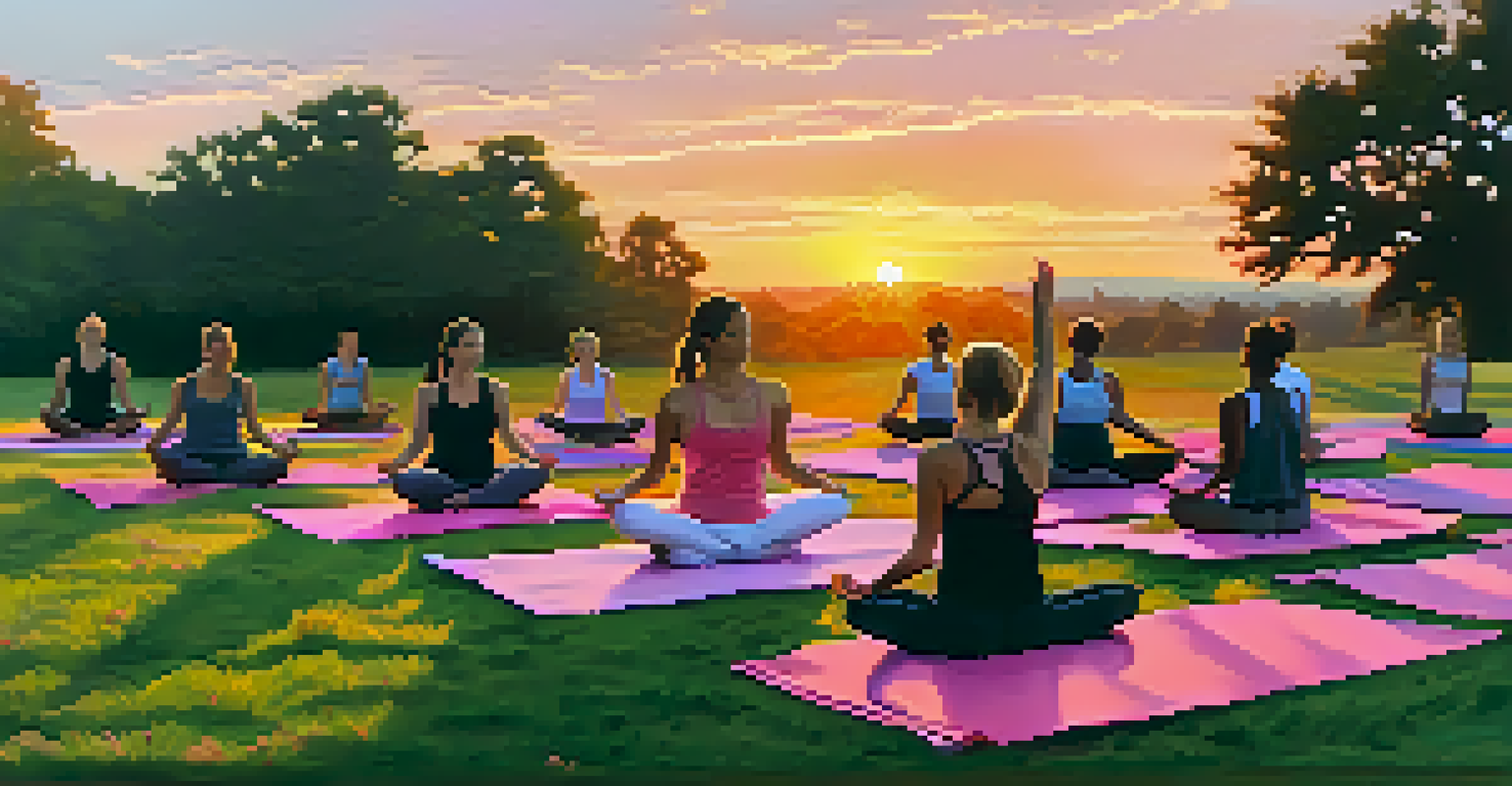Mindfulness Meditation Techniques for Better Yoga Focus

Understanding Mindfulness in Yoga Practice
Mindfulness is the practice of being fully present in the moment, and it plays a crucial role in enhancing your yoga experience. It encourages awareness of your thoughts, emotions, and physical sensations, which can deepen your connection to each pose. By incorporating mindfulness into your yoga practice, you can cultivate a sense of calm and clarity that enhances focus.
Mindfulness isn't difficult. We just need to remember to do it.
Imagine practicing yoga while letting go of distractions, such as your to-do list or the noise around you. Instead of thinking about what’s next, mindfulness allows you to immerse yourself in each breath and movement. This shift in perspective can transform a routine practice into a deeply enriching experience, fostering both physical and mental benefits.
Engaging fully in your yoga practice through mindfulness can help reduce stress and increase your overall well-being. When you're focused and present, you'll notice improvements in flexibility, strength, and balance. Ultimately, mindfulness in yoga is about creating a harmonious relationship between your body and mind.
Breath Awareness: A Key Mindfulness Technique
Breath awareness is one of the simplest yet most powerful mindfulness techniques you can employ in yoga. By paying attention to your breath, you anchor yourself in the present moment, allowing distractions to fade away. This practice not only enhances your focus but also helps to regulate your emotions and mental state.

As you transition through your poses, consciously inhaling and exhaling can transform how you experience each movement. For instance, inhaling deeply during upward stretches can create a sense of expansion, while exhaling during forward bends can encourage relaxation. This rhythm can lead you to a more profound state of mindfulness.
Mindfulness Enhances Yoga Experience
Incorporating mindfulness into your yoga practice helps deepen your connection to each pose, reducing stress and improving overall well-being.
Incorporating breath awareness into your yoga practice encourages a deeper connection with your body. Over time, this technique can enhance your ability to concentrate, making it easier to maintain focus even during challenging sequences. It’s a simple practice that can yield significant benefits.
Body Scan Meditation to Enhance Awareness
The body scan meditation is a fantastic way to cultivate mindfulness in your yoga routine. This technique involves mentally scanning your body from head to toe, noticing any sensations, tension, or areas of relaxation. It’s a practice that helps you become more aware of how your body feels, which can enhance your yoga experience.
The mind is everything. What you think you become.
Before beginning your yoga session, take a few moments to lie down and perform a body scan. As you focus on each body part, you may notice areas that need extra attention during your practice. This increased awareness can help you approach your yoga with intention and care, ensuring you’re not just going through the motions.
Regularly practicing the body scan can lead to a greater understanding of your body’s needs. It fosters a connection that allows you to listen to what your body is telling you during yoga, ultimately improving your focus and alignment. This technique is a valuable addition to any yoga routine.
Setting Intentions for Your Yoga Practice
Setting intentions is a powerful mindfulness technique that can significantly enhance your yoga focus. An intention serves as a guiding principle for your practice, helping you stay centered and aligned throughout your session. Whether it's cultivating patience, strength, or self-love, intentions provide clarity and purpose.
Before you begin, take a moment to reflect on what you want to achieve during your practice. By articulating this intention, you create a mental anchor that reminds you to stay focused on your goal. This practice transforms your yoga from a mere physical exercise into a meaningful journey of self-discovery.
Breath Awareness Boosts Focus
Focusing on your breath during yoga not only anchors you in the present but also enhances your ability to concentrate and regulate emotions.
As you progress through your poses, keep your intention in mind. It can help you remain present and engaged, especially during challenging moments. Ultimately, setting intentions cultivates a deeper, more mindful connection to your yoga practice.
Visualization Techniques for Enhanced Focus
Visualization is a powerful mindfulness tool that can enhance your focus during yoga. It involves creating mental images of what you want to achieve or how you want to feel while practicing. This technique not only boosts concentration but also helps you embody the movements more fully.
Before your session, take a moment to visualize yourself flowing through the poses with grace and ease. Picture yourself achieving balance, flexibility, and strength. This mental rehearsal can prepare your body and mind, making it easier to stay focused when you step onto your mat.
Incorporating visualization into your practice can lead to improved performance and a deeper connection with your movements. By seeing yourself succeed, you’re more likely to experience that success in reality. This technique is a fun and engaging way to enhance mindfulness in your yoga practice.
Mindful Movement: Integrating Awareness into Poses
Mindful movement focuses on being aware of your body and breath as you transition through yoga poses. This technique encourages you to slow down and really feel each movement, rather than rushing through the sequence. By doing so, you cultivate a deeper awareness of your body’s alignment and emotional responses.
As you practice, pay close attention to how your body feels in each pose. Notice the sensations, the stretch, and even the areas that may feel tight. This heightened awareness allows you to make adjustments in real-time, ensuring that your practice is both safe and effective.
Setting Intentions Guides Practice
Establishing clear intentions before your yoga session provides clarity and purpose, transforming your practice into a meaningful journey of self-discovery.
Integrating mindful movement into your routine can lead to a more fulfilling yoga experience. By focusing on each transition, you enhance your concentration and deepen your connection with your practice. It transforms your yoga into a meditative experience that nourishes both body and mind.
Closing Your Practice with Mindfulness
Just as you begin your yoga practice with intention and awareness, it’s equally important to close it mindfully. Taking a few moments at the end of your session to reflect on your practice can help reinforce the benefits of mindfulness. This closing ritual allows you to acknowledge your efforts and cultivate gratitude.
Consider sitting in a comfortable position, closing your eyes, and taking several deep breaths. Reflect on how your body feels and the thoughts that arose during your practice. This moment of reflection can help solidify the focus and intention you set at the beginning.

Closing your practice mindfully not only enhances your yoga experience but also extends those feelings of calm and clarity into your daily life. It’s a gentle reminder to carry the lessons of mindfulness with you, making it easier to stay focused and present in all aspects of your day.